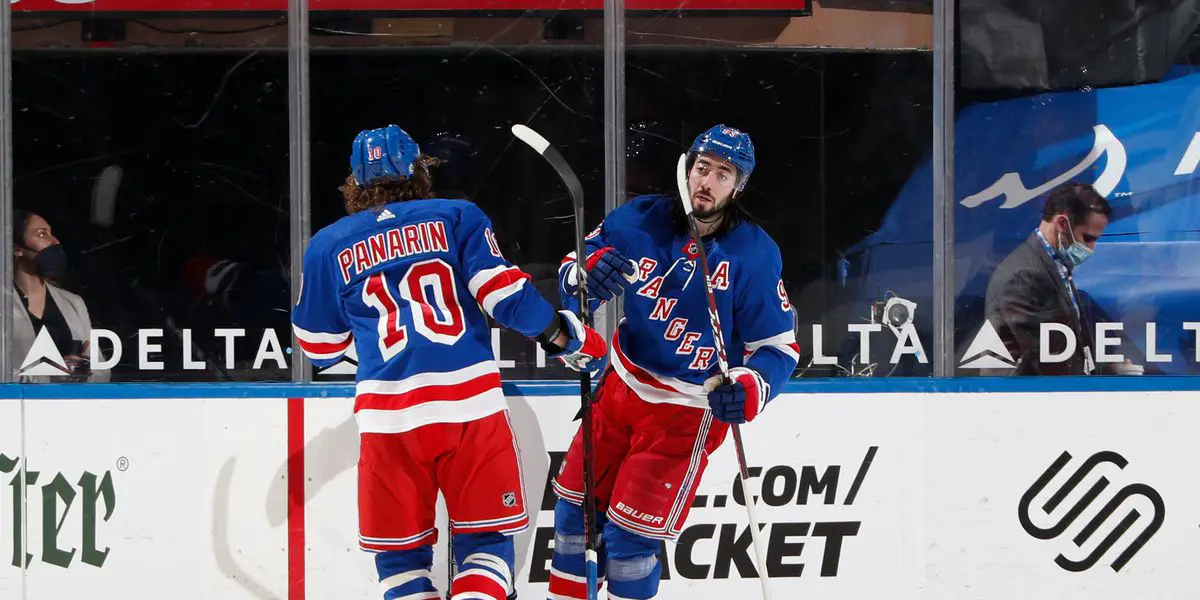
While the Rangers have certainly been imperfect, this team is built for the playoffs; and when they are at their best, they play like it. While the Rangers have been spectacular as of late, defying underlying stats like their expected goals percentage (which has steadily declined despite the team winning), their power play has been sub-par. The Rangers need to have a successful power play unit, as without it, they could lose valuable points that might come back to bite them in April. So to score more, what does this team need to do? Even though they are still getting chances, a change might be required on the power play to keep themselves one step ahead of their opponents.
The Current Situation
For the most part, the Rangers’ power play has been average. What was one of the best power plays last year has become predictable. A 22.5% conversion rate is good enough for 15th best in the league, which is around the middle of the pack. As usual, Mika Zibanejad is the Rangers’ Alex Ovechkin or Tage Thompson, as he scored 12 of his own 19 goals on the power play from that position at the top of the circle. Defenseman Adam Fox and forwards Chris Kreider, Vincent Trocheck, and Artemi Panarin round out the Rangers’ top unit for a power play that has become rather mundane. Although this unit has been Gerard Gallant’s go-to squad to get results on the power play, it has not been reliable in sustaining its success.
This is where things get a little rough. The second unit rotates Jacob Trouba, Kaapo Kakko, Alexis Lafrenière, Filip Chytil, and a combination of Barclay Goodrow, Vitali Kravtsov, and Sammy Blais has been invisible. This unit has combined for just four power play points this season. Neither the second unit nor the first unit has produced up to their level this season, and for a team that ranks 15th in the league on the power play from the top unit alone, that is just not good enough. The second unit lacks prominent all-star passers such as Panarin or Fox to anchor them on the blue line. Besides being rarely allowed to play, the kids have yet to gel together on the power play. Jacob Trouba is proficient in creating rebounds from the point, which is helpful in its own right, but accurate shots are a necessity on the power play.
What can be done to fix the second unit?
A couple of changes should be made, which all revolve around utilizing the Rangers’ young, skilled players. A simple yet easy fix could be to give K’Andre Miller some second unit time instead of his partner, Jacob Trouba. The 22-year-old Miller has the skill to anchor the blue line on the PP and could set up some nice passes for the other talented young players on this unit. Trouba is proficient in creating rebounds from the point, which is helpful for 5v5 but not as useful on the power play, where one would want a stronger, more accurate shot. Furthermore, Miller has shown his offensive prowess recently with stellar goals versus the Philadelphia Flyers and Minnesota Wild, as well as his clutch factor with his game-tying goal versus the Dallas Stars and his pass to Kaapo Kakko to give the Rangers the lead versus the Islanders. Miller has proven himself and deserves to get the PP2 point position over Trouba.
As for the rest of the unit, Alexis Lafrenière has been noticeably snakebit at 5v5, and the power play could give him the confidence to start scoring at a first-overall-pick rate. With Chris Kreider’s injury against the Wild, Lafrenière has been given his top unit spot and top-line position, so perhaps this boosts his confidence. He even got to start overtime versus the Stars, and some power play time would be fantastic for his confidence, something he desperately needs. The more opportunities that Lafrenière is relied upon, the better player he will be.
Filip Chytil has shown tremendous shooting ability from high-danger areas in the slot and can be used in the bumper position in an effective role. Furthermore, Kaapo Kakko needs to use his 6’2″ frame in front of the net. He could learn a lot from a player like Kreider, who led the league in goals by deflection last year, and can be a solid net-front presence on that second unit. Kakko has made incredible strides in his game, and his confidence and level of play have reached another level, even if the points aren’t coming just yet. Lastly, Vitali Kravtsov has shown he can be a strong puck mover and sniper. With all of this skill amongst the Rangers’ former first-round picks, this second unit needs to be given more trust to use that skill, especially if the first unit is struggling to score.
Should the first unit be changed?
However, if the Rangers want to get really bold, more drastic changes must be made. If the Rangers consider their first unit to be too predictable, it could be time to make some changes or split the time between both units more evenly.
One suggestion is that it is time to put Vincent Trocheck on the second unit. Trocheck has the bumper spot on the first unit, which is the spot right in the slot, and switching him and Chytil could bring a nice veteran presence to the second unit while also adding a dangerous slot shot to the first unit. Chytil has scored several goals from the slot area, particularly in overtime against the New Jersey Devils and in the playoffs versus Tampa, and would excel in that role.
Adding Trocheck to the second unit would stabilize that unit as well. If we move forward with the idea that the second unit is now Trocheck, Kakko, Lafrenière, Kravtsov, and Miller, Trocheck’s ability in the faceoff dot, as well as his position in front of and around the net, could bring the second unit more success. Furthermore, it allows the time between both units to be split more evenly, making the Rangers’ power play all the more deadly.
The Future
While we debate about who should be on what unit, every hockey player’s greatest enemy encroaches on the New York Rangers. Artemi Panarin and Chris Kreider are both 31 years of age and will inevitably show signs of decline soon. This means their long-term future as New York Rangers is somewhat in question, as their ability to perform at a high level will be on the decline. More importantly, their respective roles on the power play as puck distributor and net-front presence will begin to be in question.
Panarin is already showing signs that he isn’t playing as well as he once was. Perhaps this was due to the lack of chemistry between him and Trocheck, but it is a little concerning that Panarin isn’t playing up to the level we know he can. Kreider is playing phenomenally as of now, so he is less of a concern, but with age, the debate will have to come up about what to do with him and Panarin.
Luckily, the Rangers have been blessed with two top 2 picks in Kaapo Kakko and Alexis Lafrenière, who they should look to fully utilize their potential. In Lafrenière’s draft year, he had more than double the number of assists as he did goals, indicating his ability to pass the puck. I would love to see a change to use Lafrenière where Panarin currently is, as they play the same position, and he could fit easily into that role. Moreover, I would also love to see Kakko used in that net-front role where Kreider is now, as he has shown his ability to score goals near the front of the net, and I believe he could excel in that role.
Even if Panarin and Kreider fell off a cliff production-wise, the Rangers have more than enough talent in the wings waiting to jump at an opportunity to play. While the power play has not been good enough this season, the Rangers needn’t be concerned about its production, but this does not mean changes do not need to be made.

Stanley Cup Aspirations – Cue’ the Duck Boats Pod
Discover more from Inside The Rink
Subscribe to get the latest posts sent to your email.



